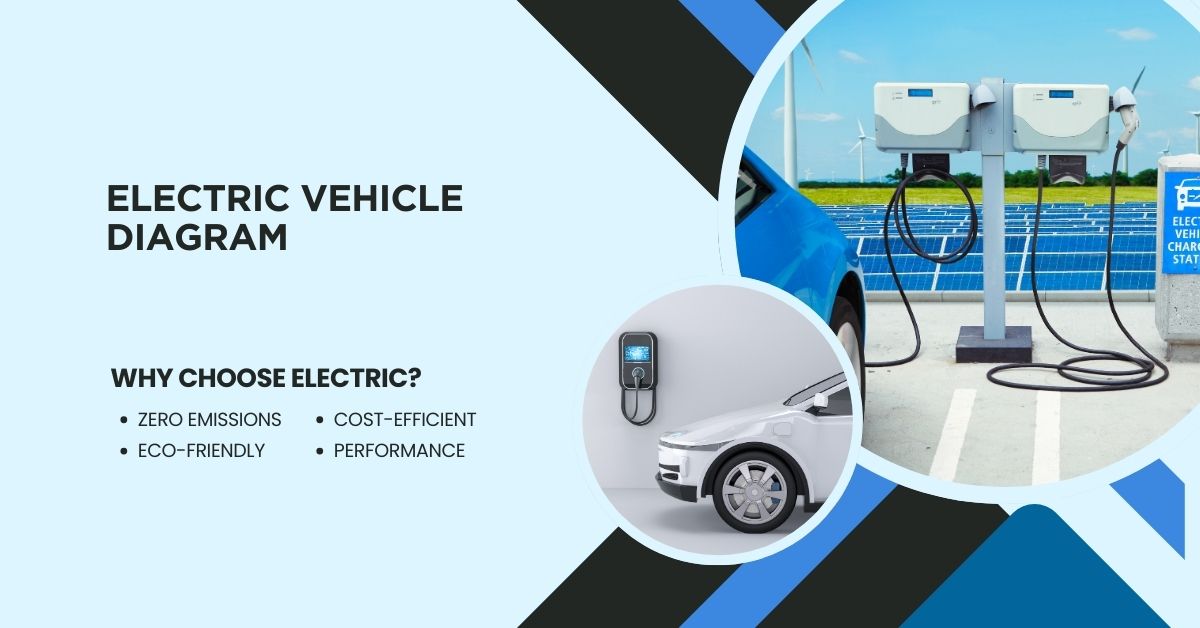Electric Vehicle Diagram
“Explore the comprehensive guide on Electric Vehicle Diagram to understand EV systems’ key components and workings. This informative overview breaks down the structure of electric vehicles, including motor placement, battery packs, charging systems, and power management flow. Whether you’re an automotive enthusiast, an engineer, or simply curious about the mechanics behind EVs, this post offers clear and detailed insights into how each part interconnects to drive the future of sustainable transportation. Enhance your knowledge with practical, easy-to-read schematics that demystify the electric vehicle’s architecture, making complex concepts accessible for all readers.”
Table of Contents
Electric Vehicle Diagram Overview
An electric vehicle (EV) diagram visually represents the main components and systems that power and operate an EV. This diagram typically highlights the key electrical, mechanical, and control systems involved in the propulsion of the vehicle. Understanding these components is crucial for grasping the functionality and design of EVs.
Key Components in an Electric Vehicle Diagram

- Electric Motor
- Function: The electric motor converts electrical energy stored in the battery into mechanical energy, driving the vehicle’s wheels.
- Types: Common types include AC induction motors, permanent magnet synchronous motors (PMSMs), and brushless DC (BLDC) motors.
- Placement: Positioned near or on the axle(s) to ensure effective power delivery to the wheels.
- Battery Pack
- Function: The battery pack stores electrical energy and supplies power to the motor and other systems in the EV.
- Composition: Typically made up of hundreds or thousands of lithium-ion cells connected in series and parallel arrangements.
- Battery Management System (BMS): Ensures optimal performance by monitoring charge levels, temperature, and health of the battery cells.
- Power Inverter
- Function: Converts the direct current (DC) from the battery into alternating current (AC) to power the electric motor, and vice versa for regenerative braking.
- Role in Regeneration: Captures kinetic energy during braking and converts it back to electrical energy, which is stored in the battery.
- Controller/Power Electronics Controller
- Function: Acts as the brain of the EV, managing the flow of electricity between the battery, motor, and other systems.
- Operation: Modulates the inverter’s output, regulates the motor’s speed, and ensures efficient operation based on input from the driver (e.g., acceleration or deceleration commands).
- Onboard Charger (OBC)
- Function: Converts AC power from an external charging source to DC power for charging the battery.
- Charging Types: Supports slow (Level 1), moderate (Level 2), and fast (Level 3 DC fast charging).
- Thermal Management System
- Function: Maintains the temperature of key components like the battery, motor, and inverter to ensure efficient and safe operation.
- Cooling Methods: Liquid cooling is the most common method, though some systems may use air cooling or other advanced cooling techniques.
- Regenerative Braking System
- Function: Enhances energy efficiency by converting kinetic energy into electrical energy during braking and storing it in the battery.
- Integration with the Controller: Works seamlessly with the motor and inverter to provide a smooth transition between driving and braking modes.
- Drivetrain
- Types: EVs can have different drivetrain configurations such as front-wheel drive (FWD), rear-wheel drive (RWD), or all-wheel drive (AWD).
- Direct Drive vs. Multi-Gear Systems: Most EVs use direct drive systems due to the electric motor’s ability to provide maximum torque from a standstill.
Detailed Breakdown of the Electric Vehicle Diagram

Battery Pack and BMS (Battery Management System)
The battery pack is the heart of the EV, providing the energy required to drive the motor and auxiliary systems. The BMS plays a pivotal role in ensuring the safety and longevity of the battery by balancing the cells, preventing overcharging or deep discharging, and managing thermal performance.
- Cell Composition: Each cell in a lithium-ion battery pack operates at about 3.6–3.7V, and packs can have various series/parallel configurations to achieve the desired voltage and capacity.
- Temperature Control: A critical part of the BMS, temperature sensors monitor the heat levels of the cells, activating cooling mechanisms as needed.
Power Inverter and Motor Interaction
The power inverter’s primary job is to take the DC from the battery and convert it to AC for motor use. This conversion is vital for an AC motor to operate since most traction motors in EVs require AC input to generate a rotating magnetic field.
- Inverter Features: High-efficiency inverters include advanced algorithms that help control motor torque and speed with minimal energy loss.
- Regenerative Mode: During braking, the inverter switches modes to convert the AC generated by the motor back into DC, effectively recharging the battery.
Electric Motor Types Explained
The choice of an electric motor affects an EV’s performance, efficiency, and cost:
- AC Induction Motors: Known for being robust and capable of high performance, these motors use electromagnets to generate a rotating magnetic field.
- Permanent Magnet Motors: These are more efficient and compact, making them popular in high-performance EVs.
- Brushless DC Motors: Offer excellent efficiency and low maintenance due to the absence of brushes that wear out over time.
Advanced Components in Modern EV Diagrams
- DC-DC Converter
- Purpose: Reduces the high-voltage DC from the main battery pack to low-voltage DC, powering 12V auxiliary systems like lighting, infotainment, and air conditioning.
- Significance: Essential for managing power distribution efficiently across the EV’s subsystems.
- Electric Power Steering (EPS)
- Function: Uses an electric motor to assist steering, reducing the driver’s effort.
- Efficiency Advantage: Only draws power when steering assistance is needed, unlike traditional hydraulic systems.
- High-Voltage Cabling
- Design Considerations: Ensures safe transmission of power between the battery, inverter, and motor. High-voltage cables are typically color-coded (orange) for easy identification and safety.
EV Charging Infrastructure Integration
Understanding the EV diagram includes recognizing how the vehicle interacts with external charging infrastructure:
- Charging Ports: Allow the EV to connect with charging stations and power sources. Common standards include Type 2 (Europe), CCS (Combined Charging System), and CHAdeMO.
- Vehicle-to-Grid (V2G) Capability: Some EVs are designed to feed electricity back into the grid, contributing to energy management during peak demand.
Simplified Block Diagram of an Electric Vehicle
A simplified EV block diagram includes:
- Battery Pack → Inverter → Electric Motor → Drivetrain: The basic flow of power from energy storage to wheel movement.
- Regenerative Pathway: Electric Motor → Inverter → Battery Pack.
- Charging Pathway: External Power Source → Onboard Charger → Battery Pack.
Illustration of the EV Diagram Components
For readers interested in practical visualization, a detailed diagram showcasing how these components connect is ideal. It typically includes labeled sections showing how the power flows from the battery to the motor, the role of the inverter, and how the BMS oversees battery health.
Importance of the EV Diagram in EV Design and Maintenance

- Design Insights: Engineers use these diagrams to design more efficient, compact, and powerful EVs.
- Troubleshooting: Technicians rely on comprehensive diagrams to diagnose and repair issues related to battery, motor, or electrical failures.
FAQs About Electric Vehicle Diagram
Q1. What is an Electric Vehicle (EV) diagram?
An EV diagram is a schematic representation that shows the main components and workings of an electric vehicle, illustrating how energy flows from the battery to the motor and other key systems.
Q2. What are the primary components shown in an EV diagram?
Typical components include the battery pack, electric motor, power electronics controller, charger, thermal management system, and drivetrain, among others.
Q3. How does an EV diagram help in understanding electric vehicles?
An EV diagram helps by visually demonstrating how the different parts of the vehicle interact, making it easier to understand the flow of electricity, power conversion, and the basic operational structure of an EV.
Q4. Why is the battery pack crucial in an EV diagram?
The battery pack is depicted as the main energy source in an EV. It powers the motor and is essential for the vehicle’s operation. The diagram highlights its connection to the motor and control systems.
Q5. What role does the power electronics controller play in the diagram?
The power electronics controller regulates the flow of electric power from the battery to the motor and other systems, controlling speed and torque according to the driver’s inputs.
Q6. How is energy regeneration shown in an EV diagram?
Energy regeneration, such as that from regenerative braking, is often illustrated by a feedback loop in the diagram where energy flows back to the battery during braking or deceleration.
Q7. What does the drivetrain look like in an EV diagram?
The drivetrain in an EV diagram shows the link between the electric motor and the wheels, usually simplified to depict the connection and torque transmission system without a traditional gearbox.
Q8. Is charging infrastructure included in an EV diagram?
Sometimes, diagrams may include the connection points or illustrate how the onboard charger interfaces with an external charging station to recharge the battery.
Q9. Can an EV diagram help identify potential maintenance issues?
Yes, understanding an EV diagram can help users and technicians identify which components to inspect or service in case of performance issues, such as those related to the powertrain or battery system.
Q10. What are the differences between an EV and a hybrid vehicle diagram?
An EV diagram shows a fully electric system, while a hybrid vehicle diagram includes both an internal combustion engine and an electric drive system, illustrating how they work together.
Conclusion
Understanding an electric vehicle diagram provides invaluable insights into how electric vehicles operate. Each component in the diagram plays a vital role in ensuring the vehicle runs smoothly, efficiently, and safely. From the battery pack and power inverter to the motor and regenerative braking system, the coordination of these elements is what propels the advancement of EV technology.
An EV diagram serves not only as an educational tool but also as a foundation for designing more innovative, eco-friendly transportation solutions that will dominate the future of the automotive industry.
